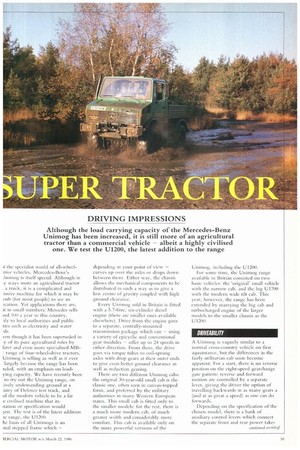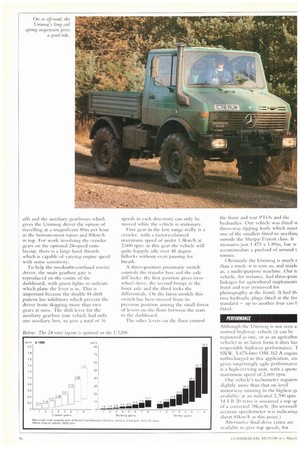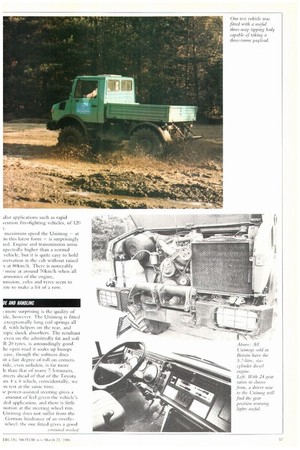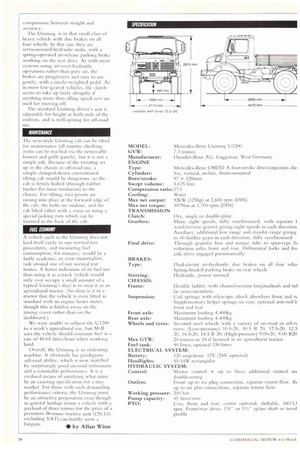DRIVING IMPRESSIONS
Page 79

Page 80

Page 81

Page 82

If you've noticed an error in this article please click here to report it so we can fix it.
Although the load carrying capacity of the Mercedes-Benz Unimog has been increased, it is still more of an agricultural tractor than a commercial vehicle — albeit a highly civilised one. We test the U1200, the latest addition to the range
the specialist world of all-wheel[rive vehicles, Mercedes-Benz's inimog is itself special. Although in ly ways more an agricultural tractor la truck, it is a complicated and :nsive machine for which it may be cult (for most people) to see an ication. Yet applications there are, it in small numbers: Mercedes sells inil 100 a year in this country, aly to local authorities and public ties such as electricity and water 7ds.
ven though it has been superseded in iy of its pure agricultural roles by later and even more specialised MB: range of four-wheel-drive tractors, Unimog is selling as well as it ever largely because the range has been nded, with an emphasis on loadying capacity. We have recently been to try out the Unimog range, on ively undemanding ground at a
istry Defence test track, and id the modern vehicle to be a far e civilised machine that its uation or specification would ;est. The test is of the latest addition Sc range, the U1200.
he basis of all Unimogs is an mal stepped frame which — depending in your point of view — Curves up over the axles or drops down between them. Either way, the chassis allows the mechanical components to be distributed in such a way as to give a low centre of gravity coupled with high ground clearance.
Every Unimog sold in Britain is fitted with a 5.7-litre, six-cylinder diesel engine (there are smaller ones available elsewhere). Drive from the engine goes to a separate, centrally-mounted transmission package which can — using a variety of epicyclic and conventional gear modules — offer up to 24 speeds in either direction. From there, the drive goes via torque tubes to coil-sprung axles with drop gears at their outer ends to give even better ground clearance as well as reduction gearing.
There are two different Unimog cabs: the original 30-year-old small cab is the classic one, often seen in canvas-topped form, and preferred by the military authorities in many Western European states. This small cab is fitted only to the smaller models: for the rest, there is a much more modern cab, of much greater width and considerably more comfort. This cab is available only on the more powerful versions of the Unimog, including the U1200, For sonic time, the Unimog range available in Britain consisted on two basic vehicles: the 'original' small vehicle with the narrow cab, and the big U1700 with the modern wide tilt cab. This year, however, the range has been extended by marrying the big cab and turbocharged engine of the larger models to the smaller chassis as the U1200.
DRVEABILITY
A Unimog is vaguely similar to a normal cross-country vehicle on first aquamtance, but the differences in the fairly utilitarian cab soon become apparent. For a start, there is no reverse position on the eight-speed gearchange gate pattern: reverse and forward motion are controlled by a separate lever, giving the driver the option of travelling backwards in as many gears a (and at as great a apeed) as one can do forwards.
Depending on the specification of the chosen model, there is a bank of auxiliary control levers which connect the separate front and rear power take
offs and the auxiliary gearboxes which gives the Unimog driver the option of travelling at a magnificent 80m per hour in the bottom-most ratios and 80km/h in top. For work involving the crawler gears on the optional 24-speed ratio layout, there is a large hand throttle which is capable of varying engine speed with Millie SCIISItiV it y. To help die no-doubt-confused novice driver, the main gearbox gate is reproduced on the centre of the dashboard, with green lights to indicate which plane the lever is in. This is important because the double H-shift pattern has inhibitors which prevent the driver from skipping more than two gears at once. The shift lever for the auxiliary gearbox (our vehicle had only one auxiliary box, to give a total of 16 speeds in each direction) can only be moved while the vehicle is stationary. First gear it) the low range really is a crawler, with a factory-claimed maximum speed of under 1.5km/h at 2,600 rpm: in this gear the vehicle will quite happily idle over 45 degree hillocks without even pausing for breath.
A three-position pneumatic switch controls the transfer box and the axle dill locks: the first position gives twowheel drive, the second brings in the front axle and the third locks the differentials. On the latest models this switch has been moved from its previous position among the small forest of levers on the floor between the seats to the dashboard.
The other levers on the floor control the front and rear PTOs and the hydraulics. Our vehicle was fitted IA three-way tipping body which must one of the smallest fitted to anything outside the Sherpa/Transit class. It measures just 1.475 x I.89m, but w. accommodate a payload of around t tonnes. Obviously the Unimog is much r than a truck: it is seen as, and mark, as, a multi-purpose machine. Our b. vehicle, for instance, had three-poin linkages for agricultural implements front and rear (removed for photography at the front). It had th, two hydraulic plugs fitted at the fro standard — up to another four can h fitted.
PERFORMANCE
Although the Unimog is not seen a! normal highway vehicle (it can be registered as one, or as an agriculnu vehicle) in its latest form it does hal respectable highway performance. 1 92kW, 5.675-litre OM 352 A engin( turbocharged in this application, an, gives surprisingly agile performance is a high-revving unit, with a quote maximum speed of 2,600 rpm, Our vehicle's tachometer registert slightly more than that on level motorway running in the highest gt available: at an indicated 2,7N1 rpm 14.5 R 20 tyres it sustained a top sp of a corrected 78km/b. (Its unusuall accurate speedometer was indicating about 81kni/l) at this point.) Alternative final drive ratios are available to give top speeds, for
alist applications such as rapid vention fire-fighting vehicles, of 120
maximum speed the Unimog — at in this latest form — is surprisingly sed. Engine and transmission noise xpectedly higher than a normal vehicle, hut it is quite easy to hold iversaticm in the cab without raised ,s at 80km/h. There is noticeably noise at around 70km/h when all armonics of the engine,
mission, axles and tyres seem to aire to make a hit of a row.
AND MOM
I more surprising is the quality of idc, however. The Unimog is fitted exceptionally long coil springs all with helpers on the rear. and :opic shock absorbers. The resultant even on the admittedly fat and soft R 20 tyres, is astoundingly good. he open road it soaks up bumps ease, though the softness does it a fair degree of roll on corners. ride, even unladen, is far more lc than that of many 7.5-tonners, itreets ahead of that of the Toyota ux 4 x 4 which, coincidentally, we an test at the same time.
ie power-assisted steering gives a . amount of feel given the vehicle's ded application, and there is little notion at the steering wheel rim. Unimog does not suffer from the German hindrance of an overlywheel: the one fitted gives a good
compromise between weight and aCCuraCy.
The Unimog is in that small class of heavy vehicle with disc brakes on all four wheels. In this case they are servo-assisted hydraulic units, with a spring-operated air-release parking brake working on the rear discs. As with most systems using air-over-hydraulic operations rather than pure air, the brakes are progressive and easy to use gently, with a nicely-weighted pedal. As in most low-geared vehicles, the clutch seems to take up fairly abruptly if anything more than idling speed revs are used for moving off.
The standard Unimog driver's scat is adjustable for height at both ends of the cushion, and is well-sprung tbr off-road use.
MAINTENANCE
The new-style Unimog cab can be tilted for maintenance (all routine checking items can be reached via the removable bonnet and grille panels). but it is not a simple job. Because of the twisting set up in the chassis in off-road use, a simple clamped-down conventional tilting cab would be dangerous, so the cab is firmly bolted (through rubber hushes for noise insulation) to the chassis. For tilting, two pivots :ire swung into place at the forward edge of the cab, the bolts are undone, and the cab lifted either with a crane or using a special jacking ram which can be inserted at the hack of the cab.
FUEL ECONOMY
A vehicle such as the Unimog does not lend itself easily to our normal test procedures, and measuring fuel consumption, for instance, would be a fairly academic, or even meaningless, task around one of our normal test routes. A better indication of its fuel use than using it as a truck (which would only ever occupy a small amount of a typical Unimog's day) is to treat it as an agricultural tractor. (So close is it to a tractor that the vehicle is even fitted as standard with an engine hours meter, though this is hidden away on the timing cover rather than on the dashboard.)
We were unable to subject the U1200 to a week's agricultural use, but M-B says the vehicle should COnSUMe fuel at a rate of 45-65 litres/hour when working hard.
Overall, the Unimog is an endearing machine. It obviously has prodigious off-road ability, which is now matched by surprisingly good on-road refinement and a reasonable performance. It is a civilised means of satisfying what must be an exacting specification for a tiny market. For those with such demanding performance criteria, the Uniniog must he an attractive proposition even though in general haulage terms a vehicle with a payload of three tonnes for the price of a premium 38-tonne tractive unit (C28,135 excluding VAT) can hardly seem a • by Allan Winn






















































































